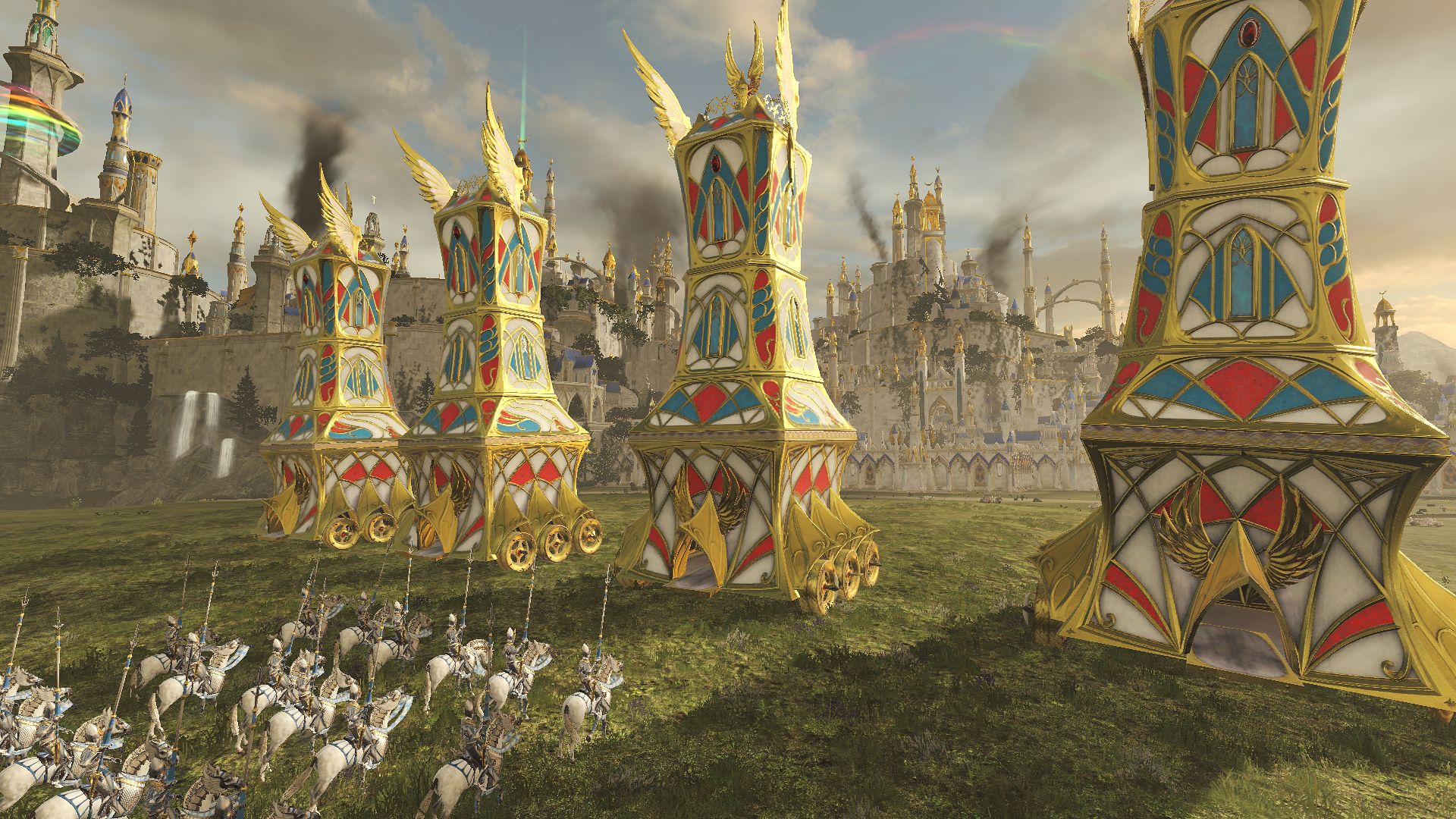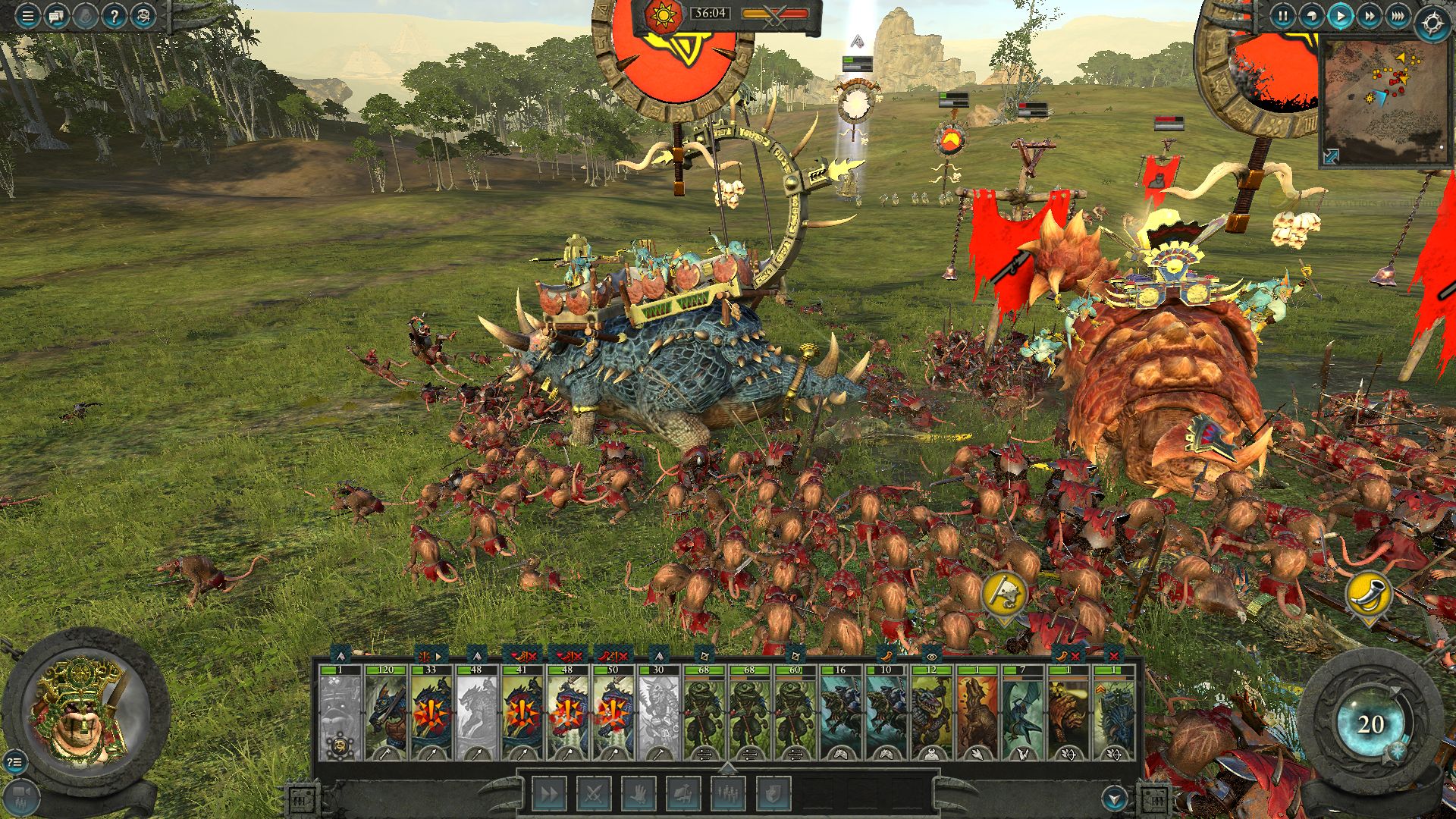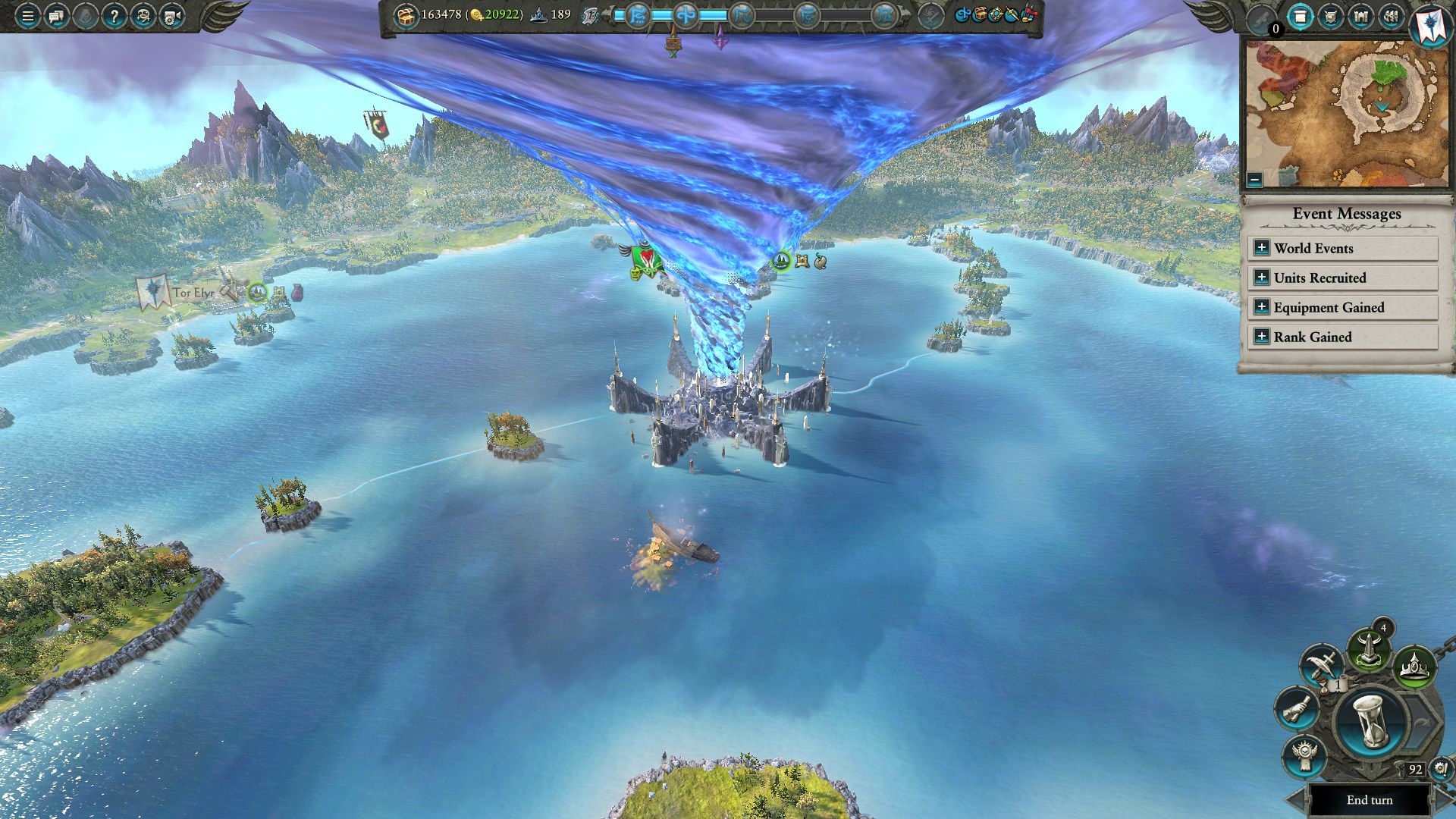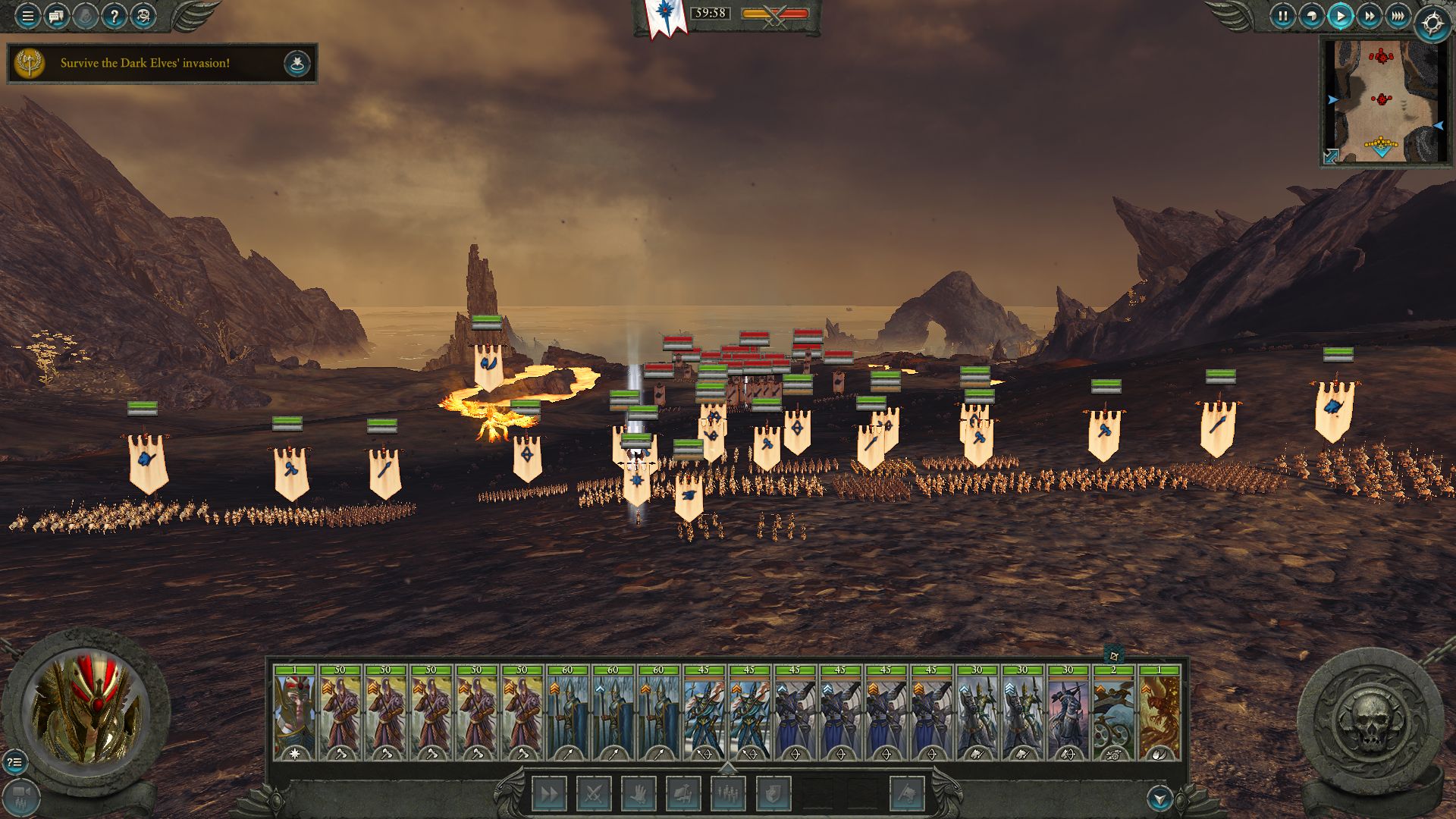Our Verdict
A maximalist sequel that improves on almost every aspect of the first game.
PC Gamer's got your back
Need to know What is it? The Total War series' real-time tactics and turn-based strategy, with even more Warhammer theming.
Reviewed on: Windows 10, GeForce GTX 960, Intel Core i7, 8GB RAM
Price: £40/$60
Release date: September 28
Publisher: Sega
Developer: Creative Assembly
Multiplayer: Up to 8 players, online and local
Link: Official site
Buy it: CDKeys
I don't remember the name of the desert. It was somewhere near the Black Pyramid of Nagash, split down the middle by a crevasse. A narrow band of dirt connected the two sides. The undead, lacking missile troops, scurried across the sand towards this bridge. My High Elves moved to block them with a line of spears, but I'd forgotten that my general's last upgrade was a warhorse. Instead of moving up with the line he raced ahead unnoticed and was now alone, facing down sprinting ghouls, shambling zombies, and the Vampire Countess leading them.
Rather than retreat I ordered the Silver Helm knights to rush in (I'd been keeping them in reserve to flank-charge anyone who broke through the spear line and pushed toward my archers), and instead of a strategic defence the Battle of Nameless Crevasse turned into a massed and messy cavalry charge. In war, they say no plan survives contact with the enemy. In Total War: Warhammer 2 no plan survives my ability to get distracted by how nice the unit animations are.
It's typical for each Total War game to be followed by a smaller sibling, a high quality standalone expansion as Attila was to Rome 2 or Fall of the Samurai was to Shogun 2. Warhammer has gone in the opposite direction. We had one large-scale strategy game of turn-based campaigning and real-time battles in the fantasy setting of the Old World, and now a year later we get another, bigger one—with promise of a third still to come.
Where the first game gave us a fantasy analogue of continental Europe, Total War: Warhammer 2 includes mythed-up analogues of the Americas, Africa, and Britain as well as a horseshoe-shaped continent in the mid-Atlantic called Ulthuan, home of the High Elves. It breaks up the ocean nicely so you're not staring at a ship for 50 turns to get anywhere, although there are also plenty of sunken treasure galleons and lost islands and dead behemoths to encounter along the way as well. Every time you set sail a little story plays out, which is a nice way of livening things up without having to add naval combat.
As well as being the centre of the ocean, Ulthuan is the centre of the campaign. In Warhammer 2 you can win by old-fashioned domination or by meeting the objectives required to take control of the great vortex, a cyclone of magical energy hovering over an island in the middle of Ulthuan that the four playable factions all want to control using a sequence of rituals. It provides more structure to the game, and since everybody's after the same thing, it feels more like a race.
Total War: Warhammer emphasised the differences between its fantasy armies. Vampire Counts had no missile troops; Dwarfs had no spellcasters; and Greenskins had no trousers.
In the historical Total War games the factions are usually pretty similar, which helps make them balanced. Total War: Warhammer emphasised the differences between its fantasy armies. Vampire Counts had no missile troops; Dwarfs had no spellcasters; and Greenskins had no trousers. Those contrasts made for differences in strategy that gave it more life, and replaying the campaign became a much more enjoyable prospect than it was when choosing slightly different Japanese clans. I've racked up over 200 hours in the first game due to that, although the DLC helped extend that longevity.
At first glance the four factions of Warhammer 2 seem less distinct from each other. There are two flavours of Elves, High and Dark, and two kinds of animal-people—the dinosaur-riding Lizardmen and the mad science rats called Skaven. All are good at magic, all have a mix of melee and ranged specialists. In play, they're more different than expected. Like the armies added to the first game as DLC, extra care has been made to make them mechanically distinct in both battles and campaign.
Keep up to date with the most important stories and the best deals, as picked by the PC Gamer team.
The Skaven, for instance, spread corruption like the Vampire Counts did, but this corruption affects their own troops as well as enemies. Instead of squatting in a castle brooding while the surrounding lands turn dark and then finally slouching across the border, the Skaven are constantly moving, ruining each province—literally, their settlements appear as ruins to casual inspection—and moving on. They struggle with hunger as well; their food supplies run low if they stop raiding. Playing as the Skaven you're discouraged from settling down.
Compare that to the courtly High Elves, who instead only have to worry about a secondary currency called influence they can spend to engage in intrigue, altering how much other countries like each other. The High Elves can, with patience, win over distrustful and distant nations and turn them into allies, while breaking up alliances between their opponents. Their spies can also see any port they have a trade agreement with, lighting up far parts of the map. You can manipulate foreign affairs without even leaving your defensible island home.
The Skaven's menace below trait lets them summon units from beneath the ground to block charges or harass archers.
Distinctions on the battlefield matter too. The Skaven's menace below trait lets them summon units from beneath the ground to block charges or harass archers. Some Lizardmen go into an uncontrollable rampage when hurt, while the Dark Elves can call in bombardments from their floating black arks if fighting on the coast. Magical units like the Skaven's screaming bell as well as giant monsters like the Lizardmen's carnosaur and Elven dragons all play their part but it's the new abilities that feel like an essential part of the game, that will make going back to its predecessor feel like something is missing.
The ratmen are the most distinctive of the setting's creatures and its most beloved. So yes, if you play as the Skaven you get to throw glass balls full of poison at people, roll around in a giant electric wheel like a hamster, blast flamethrowers with abandon, and hear everyone talk in high-pitched squeaky voices. You get Rat Ogres who knuckle the ground like gorillas and bellow, and the unit animations really are distractingly nice.
There are so many tiny improvements in Warhammer 2 it's hard to list them all. The notifications when you press end turn without doing something the computer expects you to do aren't as obnoxious; heroes are less essential and the AI relies on them less; the map seamlessly zooms up into the tactical level (though I'll have to wait for an equivalent of the mod that let me zoom in for close-ups in the first game); rogue armies made of mixes of different factions roam around to add variety to battles. Instead of constructing buildings that unlock another building's ability to produce a specific elite troop, you are often constructing buildings that unlock parts of the tech tree. These are all individually small tweaks but definite improvements nonetheless.
That does rather highlight the one thing that hasn't been improved, which is the bizarre side of diplomacy. People will still scream “Traitor!” if they have any reason to dislike you no matter how slight, and neighbours will greet neighbours as if meeting travellers from distant lands. Once you get used to the maths behind it the diplomacy starts to make a kind of sense, but the disconnect between what's being said and what's meant is still distracting. So is the endless repetition of the same demands being made every turn no matter how many times you refuse to sue for peace or declare war on a trade partner's enemy.
One new flaw is that the growing scale has resulted in a map with slightly more obvious gaps in it. The Southlands are a patchwork mish-mash of new factions and old, and presumably the pseudo-Egyptian Tomb Kings will be added to it as DLC. It would be great if the army of Araby (which last appeared in a tabletop game called Warmaster in 2009) showed up as well, since their home is currently full of zombies and white guys. Over in the Lustrian jungle, home of the Lizardmen, the Amazons (who still have a team in Warhammer's weird football spin-off Blood Bowl) are another obvious omission.
Though the first game's aggressive DLC schedule upset some players, it was clearly a success or they wouldn't have kept making them. And the free offerings alongside each one seemed generous enough to me—in fact, the Bretonnians were better than any of the paid DLC factions. Among the additions coming for free this time is the ability to combine both games into something called the “Mortal Empires Campaign”, making this ridiculous map even bigger. Total War: Warhammer was a great game at launch that became even better as it grew, and Warhammer 2 feels like it's starting from the point it left off from.
A maximalist sequel that improves on almost every aspect of the first game.

Jody's first computer was a Commodore 64, so he remembers having to use a code wheel to play Pool of Radiance. A former music journalist who interviewed everyone from Giorgio Moroder to Trent Reznor, Jody also co-hosted Australia's first radio show about videogames, Zed Games. He's written for Rock Paper Shotgun, The Big Issue, GamesRadar, Zam, Glixel, Five Out of Ten Magazine, and Playboy.com, whose cheques with the bunny logo made for fun conversations at the bank. Jody's first article for PC Gamer was about the audio of Alien Isolation, published in 2015, and since then he's written about why Silent Hill belongs on PC, why Recettear: An Item Shop's Tale is the best fantasy shopkeeper tycoon game, and how weird Lost Ark can get. Jody edited PC Gamer Indie from 2017 to 2018, and he eventually lived up to his promise to play every Warhammer videogame.





